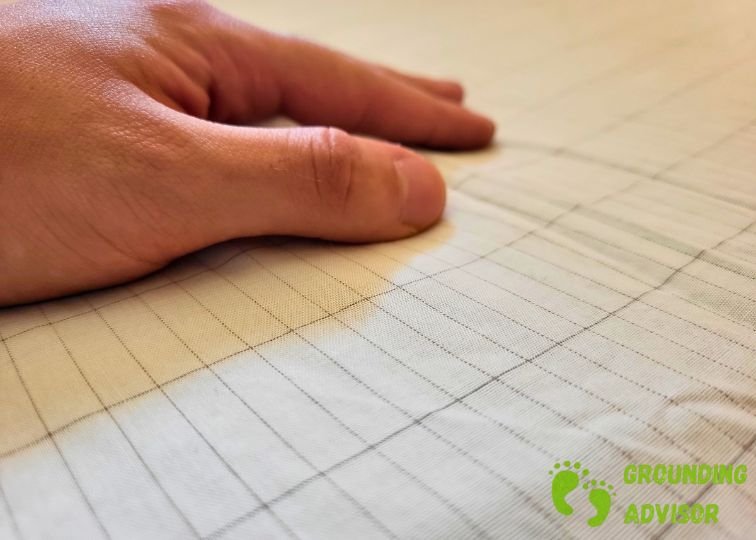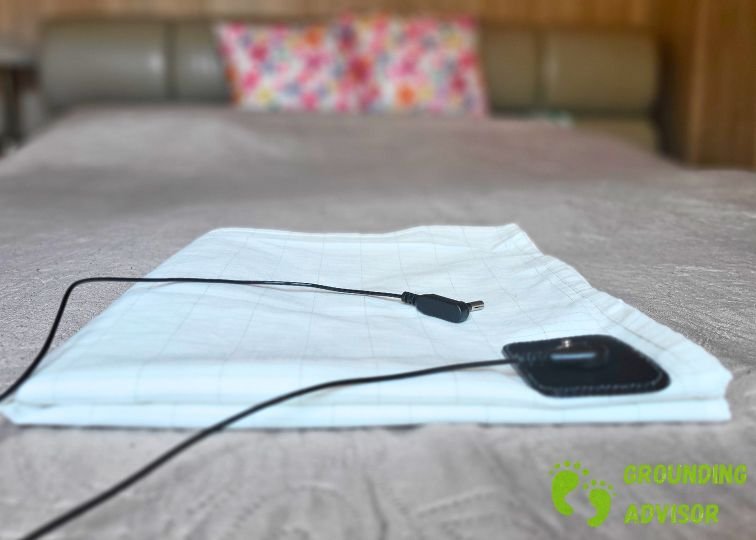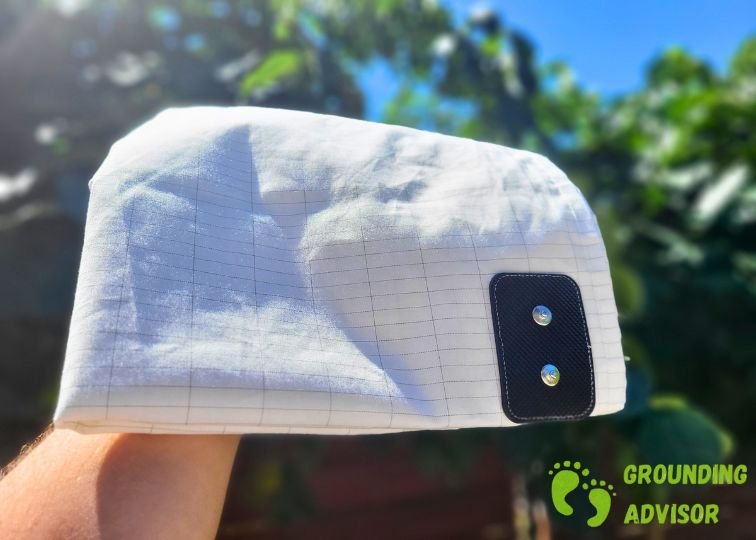The biggest question I kept getting asked, and frankly, the one I was most curious about myself: what on earth are these grounding sheets actually made of? It sounds a bit space-age, sleeping on something designed to connect you to the planet. Let’s pull back the covers, literally and figuratively, and explore the materials that make these sheets so unique.
What Are Grounding Sheets Made of?
Maybe you’re wondering if you’ll be sleeping on some kind of strange, metallic contraption. The good news is, for the most part, grounding sheets are designed to feel pretty much like your regular bed linens.
The secret lies in a clever combination of materials:
The Base Fabric
This is usually a comfortable, breathable material like cotton. You’ll often see organic cotton, which is a nice touch. Sometimes, bamboo or other soft, natural-feeling fibers are used. The primary goal here is comfort, because who wants to sleep on something that feels scratchy or stiff?
The Conductive Element
This is where things get interesting. Woven into the base fabric are incredibly fine threads of a conductive material. The most common one you’ll find is silver. Yes, actual silver! Silver is an excellent conductor of electricity – one of the best, in fact. It’s also known for having other properties that people appreciate in bedding.
Interestingly, beyond its conductivity, silver has a long and storied past; for centuries, people have recognized its unique qualities, even using it in fine textiles or for its natural ability to keep things fresh. It’s quite remarkable how an ancient material finds its place in modern wellness.
You might also see stainless steel threads or sometimes carbon-infused materials, often seen in the best grounding mats.
These conductive threads are usually so fine that you can barely see or feel them. They might be woven in a grid pattern or as individual strands throughout the fabric. The aim is to create a conductive surface across the sheet.
How Do These Materials Actually Work?
Okay, so we have cotton and silver threads. How does that connect you to the earth? Well, the sheet itself is only part of the system. Grounding sheets come with a cord. One end of this cord snaps onto a connection point on the sheet (usually a little metallic stud). The other end plugs into the ground port of a standard three-prong electrical outlet.
The cord only connects to the ground wire in your outlet. It doesn’t connect to the electrical power lines. Think of it like this: many of your household appliances have a three-prong plug, right? That third prong is the ground, connecting the appliance to the earth for safety and proper function.
Grounding sheets use that same principle for your body, aiming to stabilize your natural bioelectrical environment by connecting you to the earth’s own subtle charge. That ground wire in your home’s electrical system runs directly to a grounding rod buried in the earth outside your house.
So, the sheet, via the cord and your home’s grounding system, creates a direct pathway for you to connect with the earth’s surface, just as if you were standing barefoot outside. It’s quite ingenious, really.
My Experience
Initially I was a bit skeptical. Would it feel weird? Would I notice the threads? But honestly, a well-made grounding sheet feels remarkably like a normal, high-quality cotton sheet. The silver threads are typically so fine and integrated so well that they don’t change the texture much, if at all. You get the comfort you expect from your bedding, with the added dimension of that conductive connection.
Are There Fake Grounding Sheets?
This is a really important question, and unfortunately, the answer is yes. As with any product that gains popularity, imitations and low-quality versions can appear. The trouble with fakes is that they might look the part, but they won’t provide the conductive connection that’s essential for grounding. They might skimp on the silver content, use non-conductive look-alike threads, or have faulty connection components.
How to Tell If Grounding Sheets Are Real?
How can you improve your chances of getting an authentic, effective grounding sheet? It’s not always easy, but here are a few things I’ve learned to look for:
Check Out My Guide
One of the first things you can and should do is take a look at my guide right here on the blog. I’ve put together a resource on what I consider some of the best grounding sheets, and I discuss several trusted brands I’ve encountered in my own research. I’ll be continuing to update that with more information and brands as I find them, so it’s a good starting point.
Material Disclosure
Reputable sellers are usually transparent about the materials. They’ll specify the base fabric (e.g., 95% organic cotton) and the conductive material (e.g., 5% silver thread). If this information is vague or missing, that’s a bit of a red flag.
Conductivity
The whole point is conductivity! Some people use a simple multimeter (a device that measures electrical properties) to test if their sheet actually conducts. You would test the continuity between two points on the sheet, and then from the sheet to the grounding cord. It’s a bit technical, but it’s a definitive way to check.
The Connection System
Look for a sturdy, well-made snap connector on the sheet and a properly designed grounding cord that fits securely into the ground port of an outlet.
Source and Reviews
While not foolproof, buying from established sources or those with a history of positive, detailed reviews can be a good indicator. Be wary of brand-new sellers with generic-sounding positive reviews.
Price Point
While not always true, if a deal seems too good to be true, it might be. Pure silver is a precious metal, so sheets with a significant silver content will have a certain base cost. Extremely cheap options might be cutting corners on the conductive material.
Here’s a quick rundown of what you’re generally looking for in the components:
| Component | Common Material/Type | Key Purpose |
| Base Fabric | Cotton (often organic) | Comfort, breathability |
| Conductive Thread | Silver | Provides electrical conductivity |
| Weave Style | Grid or interspersed threads | Ensures conductive surface across the sheet |
| Connection Point | Metallic snap stud | Attaches grounding cord to the sheet |
| Grounding Cord | Insulated wire with resistor | Safely connects sheet to earth ground |
It’s worth noting that some grounding cords include a built-in resistor (often around 100k ohms) for added safety. This doesn’t impede the grounding effect for your body but protects against any unlikely scenario of electricity flowing from the outlet’s ground to you, for example, during a nearby lightning strike if your home’s main grounding system was compromised. It’s a detail, but an important one for peace of mind.
Final Thoughts
I find that knowing what goes into these products, especially something as personal as what you sleep on, is really empowering. It helps you make informed choices. The blend of traditional comfort materials with modern conductive technology in grounding sheets is quite remarkable. It’s a simple concept, really (reconnecting with the earth) brought into our modern bedrooms.

Jeremiah Kowalski
I’m Jeremiah, and grounding changed my life in the best way. When I first discovered it, I had no idea how powerful simply reconnecting with the earth could be. But I also noticed that so many people were just like me at the beginning, unsure what grounding even is or how to start. That’s why I created this blog: to make grounding more approachable and practical. Product testing is a passion of mine, especially in the wellness space. I also run waterbottleadvisor.com, where I review drinkware products that support hydration and overall well-being.


![3 Best Grounding Sheets of 2025 [Personally Tested]](https://groundingadvisor.com/wp-content/uploads/2025/07/Projekt-bez-nazwy-38.jpg)
![3 Best Grounding Mats of 2025 [Personally Tested]](https://groundingadvisor.com/wp-content/uploads/2025/07/Projekt-bez-nazwy-52.jpg)

